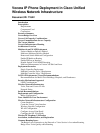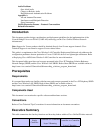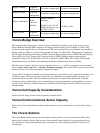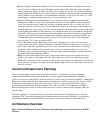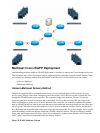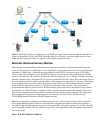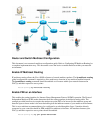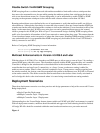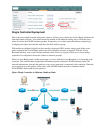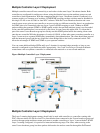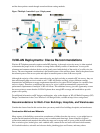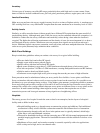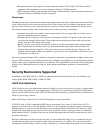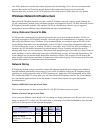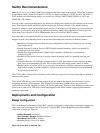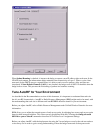Badge to Badge CommunicationsWhen one Vocera user calls another user, the badge first contacts
the Vocera server, which looks up the IP address of the badge of the callee and contacts the badge
user to ask the user if they can take a call. If the callee accepts the call, the Vocera server notifies the
calling badge of the IP address of the callee badge to setup direct communication between the badges
with no further server intervention. All communication with the Vocera server uses the G.711 codec
and all badge−to−badge communication uses a Vocera proprietary codec.
•
Badge Telephony CommunicationWhen a Vocera Telephony server is installed and setup with a
connection to a PBX, a user is able to call internal extensions off of the PBX or outside telephone
lines. Vocera allows users to make calls by either saying the numbers (five, six, three, two) or by
creating an address book entry in the Vocera database for the person or function at that number (for
example, pharmacy, home, pizza) the Vocera server determines the number that is being called, either
by intercepting the numbers in the extension or by looking the name up in the database and selecting
the number. The Vocera server then passes that information to the Vocera Telephony server which
connects to the PBX and generates the appropriate telephony signaling (for example, DTMF). All
communication between the badge and Vocera server and Vocera server and Vocera Telephony
server use the G.711 codec over unicast UDP.
•
Vocera BroadcastA Vocera Badge user can call and communicate to a group of Vocera badge
wearers at the same time by using the Broadcast command. When a user broadcasts to a group, the
user's badge sends the command to the Vocera server who then looks up the members of a group,
determines which members of the group are active, assigns a multicast address to use for this
broadcast session, and sends a message to each active users badge instructing it to join the multicast
group with the assigned multicast address.
•
Badge Location FunctionThe Vocera server keeps track of the access point to which each active
badge is associated as each badge sends a 30 second keep alive to the server with the associated
BSSID. This allows the Vocera system to roughly estimate the location of a badge user. This function
has a relatively low degree of accuracy because a Badge might not be associated to the access point to
which it is closest.
•
Vocera's Infrastructure Planning
The Vocera whitepaper Vocera Infrastructure Planning Guide , describes the site survey minimum
requirements that show that the badge should have a receive signal strength minimum of −65 dBm, a
signal−to−noise ratio greater than 25 db and proper access point overlap and channel separation. Although the
badges use a similar omni directional antenna as a notebook that is used for a site survey, it does not mimic
the behavior of the badge very well, given the wearers' affects on signal strength. Given this unique
requirement and this behavior of the transmitting device, the use of the Cisco Architecture and Radio
Resource Management is ideal in order to make sure there is a lack of unusual radio frequency (RF) site
characteristics.
The Vocera badge is a low powered device, worn next to the body with limited signal error correction
capabilities. The Vocera requirements in this document can be easily achieved. However, it can become
overwhelmed if there are too many SSIDs for it to process and allow the badge to work effectively.
Architecture Overview
Figure 1General Multicast Forward and Prune with Lightweight Access Point Protocol (LWAPP)
Wireless



